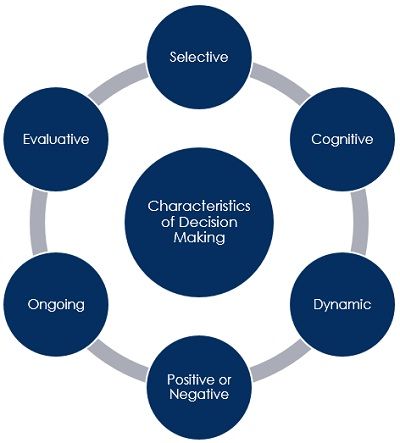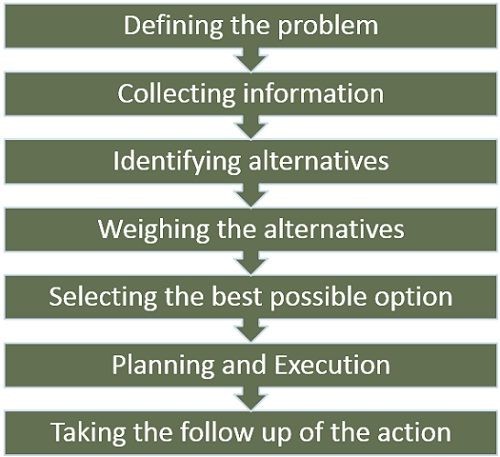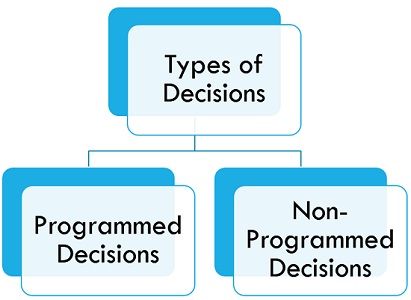Definition: Decision Making is the cognitive process of selecting a course of action, out of a set of available alternatives, so as to achieve the goals of the organization.
It is an indispensable part of the management, as decisions are made at each level by the management executives.
Characteristics of Decision Making
The characteristics of decision making are discussed as under:
- Selective: It is a selective process in which the optimal alternative is opted, among the various alternatives. The selection of the alternative is done, only after evaluating all the alternatives against the objectives.
- Cognitive: As the decision making encompasses the application of intellectual abilities, such as analysis, knowledge, experience, awareness and forecasting, it is a cognitive process.
- Dynamic: It is a dynamic activity in the sense that a particular problem may have different solutions, depending upon the time and circumstances.
- Positive or Negative: A decision is not always positive, sometimes even after analysing all the points a decision may turn out as a negative one.
- Ongoing process: We all know that a company has perpetual succession and various decisions are taken daily by different levels of management to keep the firm going. These decisions are taken, keeping in mind the objectives of the organization.
- Evaluative: Evaluation of the possible alternatives using critical appraisal methods, is a part of the decision-making process.
It is a problem-solving activity which produces a solution considered as the most favourable and appropriate one, as per the situation.
Process of Decision Making
Decision making involves the identification and selection of the alternatives on the basis of the values, preferences, requirements, and beliefs. To begin the process objectives must be defined, classified and arranged in the order of their importance.
- Defining the problem: The first and foremost step in the decision-making process is to clearly identify the problem for which a decision has to be taken.
- Collecting information: Gathering the relevant information concerning the problem is the next step in the process. For this purpose, an internal assessment needs to be done, while seeking external sources for the information.
- Identifying alternatives: After collecting the pertinent information, you will come across the multiple courses of action which can be taken to solve the given problem.
- Weighing the alternatives: On the basis of different parameters such as risk, economy for effort, timing, and limitation of resources weigh each alternative and check how accurately it resolves the issue and what are its consequences.
- Selecting the best possible option: After weighing each and every alternative, the next step in this process is to select the best possible course of action, or a combination thereof. The alternative which is able to attain the objectives is regarded as the tentative decision, which is evaluated for possible consequences.
- Planning and Execution: To convert the decision into action, the course of action so selected is taken, along with that supplementary actions are taken to block negative consequences (if any).
- Taking the follow up of the action: In the last step, the outcome of the decision is reviewed and evaluated as to whether it is capable of resolving the problem.
A decision passes through different stages, so as to solve the problem at hand. The solution depends on how effectively the decision is being made and implemented. An ideal decision is action-oriented, goal-directed and efficient.
Problems in Decision Making
There are a number of problems which arise at the time of decision making, which are:
- Accuracy
- Timing
- Communication
- Participation
- Implementation
A decision acts as a direction to the others, as to what can be done or what to avoid in a particular situation.
Types of Decisions
Decisions are classified into two categories:
- Programmed Decisions: The decisions taken by way of standard operating procedures or another method. The situations are routine and recurring in nature. These are effective for solving day to day issues.
- Non-programmed Decisions: These are unique and once in a lifetime decisions, as these are not structured. To make such decision logical reasoning and judgement are required.
Intuition and Reasoning are the two determinants of a decision, wherein intuition is all about the gut feeling or instinct of the decision-maker concerning the courses of action, while the reasoning means using the logical thinking, facts and figures to decide something.

Shalini k c says
Very useful information
Akash says
yes